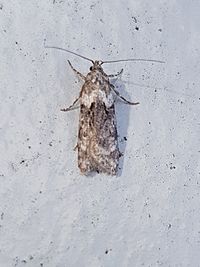Izatha convulsella facts for kids
Quick facts for kids Izatha convulsella |
|
|---|---|
 |
|
| Scientific classification | |
| Kingdom: | |
| Phylum: | |
| Class: | |
| Order: | |
| Family: |
Oecophoridae
|
| Genus: | |
| Species: |
I. convulsella
|
| Binomial name | |
| Izatha convulsella (Walker, 1864)
|
|
| Synonyms | |
|
|
The Izatha convulsella is a type of moth that belongs to the Oecophoridae family. It is found only in New Zealand, meaning it is endemic to that country. This moth looks a lot like its close relative, Izatha gekkonella. However, I. convulsella is usually a bit bigger and has more white and grey colors. It also lives in more places than I. gekkonella.
About This Moth
This moth was first described in 1864 by a scientist named Francis Walker. He gave it the name Gelechia convulsella at that time. Mr. Walker studied moths that were found in Nelson. The original moths he used to describe the species are now kept at the Natural History Museum, London.
What It Looks Like
Male Izatha convulsella moths have a wingspan (the distance from one wingtip to the other) of about 14 to 20 millimeters. Females are slightly smaller, with a wingspan of 13.5 to 19 millimeters. Adult moths can be seen flying from late September until February.
It can be tricky to tell I. convulsella apart from I. gekkonella because they look very similar. The best way to know for sure is by looking closely at the male moths. I. convulsella males have a special comb-like part in their reproductive organs.
Generally, I. convulsella is a bit larger than I. gekkonella. It also has fewer yellow-tipped grey scales on its wings. This makes I. convulsella look more white and grey. In contrast, I. gekkonella has more of these scales, giving it a browner look. The hindwings (back wings) of I. convulsella are also lighter in color compared to I. gekkonella.
Where It Lives
This moth is only found in New Zealand. It is quite common in the eastern parts of the South Island. In the North Island, it has been seen in a few specific places. These include Wellington, Ōtaki, Palmerston North, Taihape, and Waipawa. You won't find this moth in Auckland.
What It Eats
The young moths, called larvae, have been found living under the bark of Rimu trees (Dacrydium cupressinum). Scientists think that the larvae might actually eat lichens. Lichens are small plant-like growths that often grow on tree bark.
Images for kids



